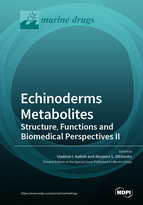Echinoderms Metabolites: Structure, Functions and Biomedical Perspectives II
A special issue of Marine Drugs (ISSN 1660-3397).
Deadline for manuscript submissions: closed (31 May 2022) | Viewed by 17557
Special Issue Editors
Interests: marine natural product chemistry; secondary metabolites; sea cucumber triterpene glycosides; biological activities; evolution of biosynthesis; chemotaxonomy
Special Issues, Collections and Topics in MDPI journals
Interests: natural products chemistry; sea cucumbers; triterpene glycosides; biological activities; chemotaxonomy; biosynthesis; NMR spectroscopy
Special Issues, Collections and Topics in MDPI journals
Special Issue Information
Dear colleagues,
The present Special Issue is a continuation of a previous successful Special Issue entitled “Echinoderm Metabolites: Structure, Functions and Biomedical Perspectives” which is currently under preparation to be reprinted as a book.
Echinoderms are marine invertebrates belonging to the phylum Echinodermata (from the Ancient Greek words “echinos” (hedgehog) and “derma” (skin)). They have radial symmetry, a unique water vascular (ambulacral) system, and a limestone skeleton and include the classes Asteroidea (starfish), Ophiuroidea (brittle stars), Echinoidea (sea urchins), Holothuroidea (sea cucumbers), and Crinoidea (sea lilies). The skeleton of sea cucumbers is reduced by ossicles. Echinoderms have no freshwater or terrestrial representatives and are habitants of every ocean depth. The phylum contains more than 7000 living species. Echinoderms are unique sources of different metabolites with a wide spectrum of biological activities. All echinoderms possess a unique mechanism of decreasing the lever of free 5,6-unsaturated sterols in their cell membranes—sulfation of these food sterols. Moreover, sea cucumbers and starfish transform these 5,6-unsaturated sterols to stanols or 7,8-unsaturated sterols that allow them to synthesize and keep their own 5,6-sterol-depending membranolytic toxins, namely triterpene oligoglycosides for sea cucumbers and steroid olygoglycosides for starfish, which have protective significance for the producers.
Starfish and brittle stars have numerous polyhydoxysteroids and their sulfated and glycosylated derivatives, using them as food emulgators. All echinoderms contain carotenoids and naphthoquinone pigments. The latter are widely presented in sea urchins. The lipid composition of echinoderms is also uncommon and very interesting. For example, they contain cerebrosides and gangliosides characteristic of other deuterostomes, including Chordata, Hemichordata, and Tunicata, relatives of echinoderms. Echinoderms contain lectins, glycan-specific glycoproteins having immunity functions for the producers, and glycoseaminoglycans. Microorganisms associated with some echninoderms and adopted to their toxins may also produce very uncommon metabolites, such as diterpene glycosides synthesized by some fungi associated with sea cucumbers. All the listed as well as other classes of echinoderm metabolites possess significant biomedical potential revealing cytotoxic, antitumor, antifungal, immunomodulatory, antioxidant activity, anti-arthritic, and anti-diabetic action and may be also used as a food supplement for nutrition.
The main goal of this second version of the Special Issue “Echinoderm Metabolites: Structure, Functions, and Biomedical Perspectives II” is also to provide a convenient platform for discussion of all possible scientific aspects concerning low molecular weight and biopolymer metabolites from echinoderms and the microorganisms associated with them, including their isolation and chemical structures, taxonomical distribution and participation in food chains, methods of analysis, biological activities, biosynthesis and evolution, biological functions, and chemical syntheses, including obtaining semi-synthetic derivatives of biologically active natural products.
Dr. Vladimir I. Kalinin
Dr. Alexanra S. Silchenko
Guest Editors
Manuscript Submission Information
Manuscripts should be submitted online at www.mdpi.com by registering and logging in to this website. Once you are registered, click here to go to the submission form. Manuscripts can be submitted until the deadline. All submissions that pass pre-check are peer-reviewed. Accepted papers will be published continuously in the journal (as soon as accepted) and will be listed together on the special issue website. Research articles, review articles as well as short communications are invited. For planned papers, a title and short abstract (about 100 words) can be sent to the Editorial Office for announcement on this website.
Submitted manuscripts should not have been published previously, nor be under consideration for publication elsewhere (except conference proceedings papers). All manuscripts are thoroughly refereed through a single-blind peer-review process. A guide for authors and other relevant information for submission of manuscripts is available on the Instructions for Authors page. Marine Drugs is an international peer-reviewed open access monthly journal published by MDPI.
Please visit the Instructions for Authors page before submitting a manuscript. The Article Processing Charge (APC) for publication in this open access journal is 2900 CHF (Swiss Francs). Submitted papers should be well formatted and use good English. Authors may use MDPI's English editing service prior to publication or during author revisions.
Keywords
- Echinoderms
- Sea cucumbers
- Starfish
- Sea urchins
- Steroids
- Terpenoids
- Glycosides
- Naphtoquinones
- Glycolipids
- Polysaccharides
- Chemical structures
- Synthesis
- Biological activity








